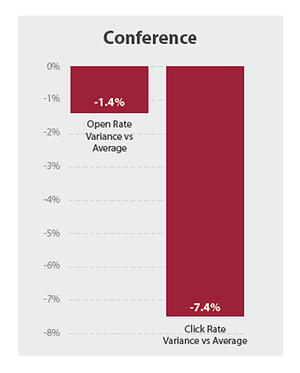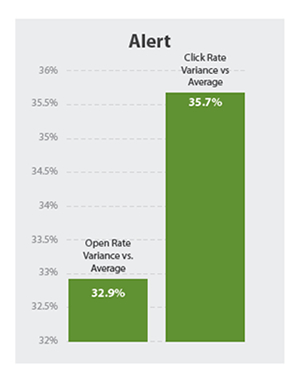Arising from our previous post New Rules For Subject Lines in B2B Email Marketing where we looked at some of the key trends affecting email performance that emerged from the 2013 Adestra Subject Line Analysis Report: “Keywords for killer subject lines”, we found a lot of good information that it gave us room to focus on the sub-set of the results that particularly affects you - B2B event marketing and B2B publishing.
As I’m sure you’ll remember me saying before, all events companies become publishers through content marketing and inbound marketing so it’s important for us to review some of those lessons too as they will help us generate more leads and engagement with our emails when we are not just hard selling our events.
Here are my key takeaways:
Don’t call your conference a "conference"
I know this sounds counter intuitive but product related words such as conference, webinar, exhibition, forum and training are all words that decrease clicks and opens. You know how crowded the events market place is nowadays, just imagine being on the receiving end of all that marketing – it’s no wonder customers switch off. Besides they are much easier words to be blocked through spam filters.
Don’t miss the boat, exclusive and limited elements still work
“Don’t miss” and “exclusive” are two very commonly used words in the B2B events industry and the good news is that they work, increasing open and click rates. A word to the wise though, make sure there’s definitely something exclusive to miss when you use the terms otherwise you’ll seem like the boy who cried wolf and spoil it for everyone. A lot of people have now caught up to the fact that the "very limited tickets" simply means "we are behind on our delegate targets".
The basic principles and rules of good direct marketing still hold
The strongest results were presented from the call to action group of words, but affected the unsubscribe rate. Reinforcing the fact that every piece of communication must contain a call to action in order to make it meaningful in terms of response but again communication must be relevant and the call to action directed to relevant landing pages. “Download” is the only word in the study to hit the holy grail of increasing opens and clicks whilst reducing unsubscribes.
Show me the money!
"Revenue", "ROI" and "money" all bolstered results, but don’t be lured into thinking that all cash references work, references to money in context of paying for the event boosted opens but killed clicks. Focus on the money they’ll save through the event lessons, the ROI and revenue they’ll generate from strategies they pick up.
Newsletters are dead, long live alerts
“Newsletter” decreases open and click through rates and is if that wasn’t bad enough it increases unsubscribes too. Conversely “Alert” and “breaking” both increase opens and clicks, from which we might extrapolate that new news is hot whereas a newsletter is now perceived as a dumping ground for old or boring content.
6 Serious Sinner Words To Avoid & Some Suggested Alternatives
We thought it’d be helpful to summarise the six words that are doing most harm to your email results (i.e. damaging your opens, clicks, click to open ration and pushing up your unsubscribe rates) and then before you sink too far into a pit of despair, we’ve come up with some alternatives too!
- Conference: Event, gathering, meeting, convention, seminar
- Offer: Deal, preferential rate, reduced rate
- Keynote: Headline, feature, highlight
- Speakers: Panel, contributors, experts, thought leaders
- Learn: Study, discover, unearth, absorb, take away, apply
- Game: Exercise, activity, interactive tool, app
All these statistics must be taken with a pinch of salt, as there are a lot of different variables affecting email marketing results and response rates. The best way is to always test and find out what works best for you.
If you’d like us to review your email copy or assist you with the development of email strategies and testing programmes that will drive up your results and deliver on-going incremental gains then do get in touch.
Credits and disclaimer: All charts and statistics used on this post have been taken from 2013 Adestra Subject Line Analysis Report: “Keywords for killer subject lines” and we strongly suggest you get a copy of the report as it is very comprehensive. We have no affiliation with Adestra whatsoever.







Do you have any comments?